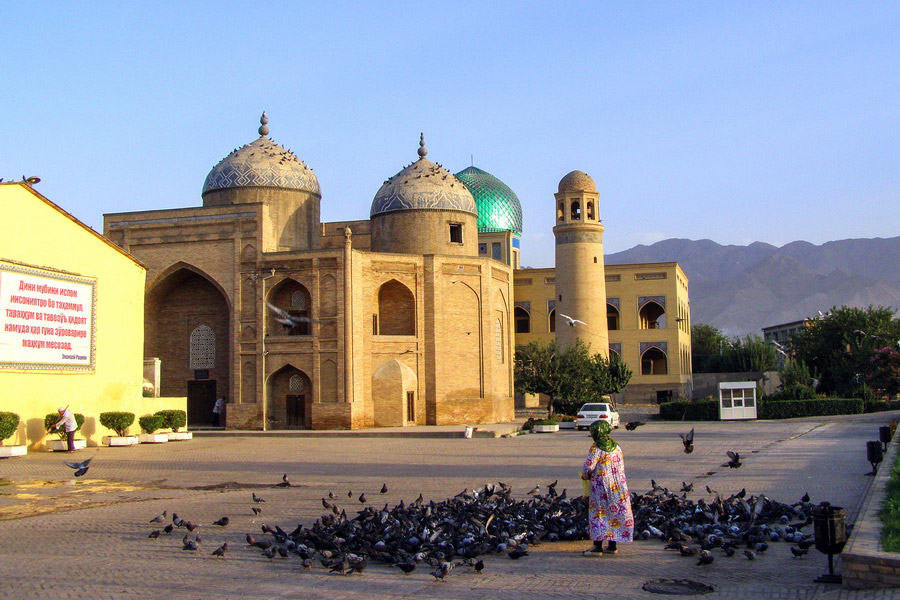Khujand, Tajikistan

Former names: Alexandria Eschate, Chucand, Khodzhent, Khohand, Khojent, Khudzhand, Leninabad
Elevation: 300 m
Official language: Tajik
Popular languages: Russian, Uzbek etc.
Nationals: Tajik, Uzbek, Russian etc.
Time zone: UTC+5
Phone code: +992 34
Zip code: 735ХXX
Automobile codes: 02
Khujand, also transliterated as Khudzhand, Khujand or Khojand, was known until 1939 as Khujend; until 1992 as Leninabad (Leninobod), is the second largest city of Tajikistan. It is situated on both sides of the Syr Darya River at the mouth of the Fergana Valley. The population of the city is about 150,000, down from 160,000 in 1989. It is also the capital of the northernmost province of Tajikistan, now called Sughd. It sits at a strategic location at the narrow western end of the Fergana Valley, almost totally surrounded by Uzbekistan. It is connected to Tajikistan proper via the Khudzhand-Dushanbe highway, currently a precarious, high altitude mountain route which is closed in winter; a complete reconstruction of the route, as well as several new tunnels (by Chinese companies) is nearing completion as of 2009.
Despite its transportation difficulties, it represents one of the most important areas of Tajikistan, with its rare fertile agricultural lands, irrigated by the Syr-Darya River, and location near the industrial centers of Uzbekistan. Major industries include Silk production, clothing and footwear manufacturing, and food processing. It has a long, colorful history as well, being at one time under the rule of Persian, Arab, Mongol and other empires; it was once the farthest northern city of Alexander the Great's empire, and was part of the Khanate of Kokand before being annexed by the Russian Empire in 1868. Unfortunately, most of these successive invaders demolished the city, and as a result few ancient treasures remain. After the Bolshevik revolution, the city was given to Uzbekistan for a time, and in 1929 it was made part of the new Tajik Soviet Socialist Republic. Tajikistan was traditionally very clan-based, and during Soviet times, most of the influence and power in the country was held by members of the Sughd clan from Khudjand (though the capital was Dushanbe).
Khujand has a very unique culture, especially within Tajikistan. The visitor will notice upon arrival not only the high level of development of the city, but the relatively large Russian and Uzbek population, far exceeding that of Dushanbe. Rarely here will you see women in traditional dress or men with long beards, and having a drink in the park is not frowned upon. The city's architecture and look has virtually not changed since Soviet days, making a trip to Khujand something of a trip back in time. Most of the Soviet-era buildings have, however, been renovated, and the city's parks and roads are also very well maintained. Despite being the second-largest city, it has a surprisingly relaxing, small-town feel, and its many lush parks and tree-lined boulevards make for a pleasant stay in the center. On hot summer days, the shady parks are full of families eating shashik and relaxing, and Tajik folk music concerts are often provided for entertainment. The real life of the city is the wide Syr-Darya River. Along the riverbanks and from bridges teenagers and children can be seen cooling off in the slow-moving water. A fast ride on one of the boats which provide transportation along the river is a great, refreshing way to see the city; high quality restaurants and cafes line the riverbanks in the center. In addition, most of the finest hotels overlook the river and mountains.
Monuments are few; the best is represented by the medieval citadel, parts of which have been reconstructed, with large round towers. It is located close to the river, along an alley 200 m west of the bridge (behind hotel "Leninobod"). The nearby Museum of Regional Studies displays artifacts discovered during the decades-long excavations here, including artifacts such as weapons, construction materials, household items and farming tools dating to the time of Alexander the Great. An old mosque is also located near the fort. Fans of everything Soviet will enjoy the largest statue of Lenin in Central Asia, on a plaza along the main road across the river from the citadel.
Weather in Khujand is continental, with long, hot and dry summers (to 50C) and short, cold and dry winters (to -25C), similar to other Fergana Valley locations. Rainfall occurs mostly in spring and fall, and snow in the winter is rare.
